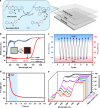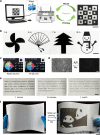Water assisted biomimetic synergistic process and its application in water-jet rewritable paper
- PMID: 30446661
- PMCID: PMC6240070
- DOI: 10.1038/s41467-018-07211-z
Water assisted biomimetic synergistic process and its application in water-jet rewritable paper
Abstract
The colour of water-jet rewritable paper (WJRP) is difficult to be expanded via single hydrochromic molecule, especially black. Here, inspired by the amazing phenomenon of bound-water in cells enabling various biological transformations via facilitating synergistic inter-/intra-molecular proton transfer, we present a simple strategy toward WJRP based on binary systems containing less-sensitive acidochromic dyes and mild proton donors (or developers). With such a binary system containing commercial black dye as the colouring agent, benzyl 4-hydroxybenzoate as the developer, and biomimetic bound-water as proton-transferring medium, we successfully achieve the long-awaited black WJRP. Printed images on such WJRP have excellent performances and long retaining time (>1 month). In addition, the robustness, durability and reversibility of WJRP could be increased distinctly by using polyethylene terephthalate as substrate. This strategy significantly expands hydrochromic colours to entire visible range in an eco-friendly way, which opens an avenue of smart materials for practical needs and industrialization.
Conflict of interest statement
The authors declare no competing interests.
Figures





Similar articles
-
Hydrochromic molecular switches for water-jet rewritable paper.Nat Commun. 2014;5:3044. doi: 10.1038/ncomms4044. Nat Commun. 2014. PMID: 24472877
-
Endowing Hydrochromism to Fluorans via Bioinspired Alteration of Molecular Structures and Microenvironments and Expanding Their Potential for Rewritable Paper.ACS Appl Mater Interfaces. 2017 Nov 1;9(43):38032-38041. doi: 10.1021/acsami.7b12363. Epub 2017 Oct 23. ACS Appl Mater Interfaces. 2017. PMID: 29024583
-
Dynamic metal-ligand coordination for multicolour and water-jet rewritable paper.Nat Commun. 2018 Jan 9;9(1):3. doi: 10.1038/s41467-017-02452-w. Nat Commun. 2018. PMID: 29317626 Free PMC article.
-
Hydrochromic Approaches to Mapping Human Sweat Pores.Acc Chem Res. 2016 Jun 21;49(6):1211-22. doi: 10.1021/acs.accounts.6b00128. Epub 2016 May 9. Acc Chem Res. 2016. PMID: 27159417 Review.
-
Biomimetic superwettable materials with structural colours.Chem Commun (Camb). 2017 Dec 5;53(97):12990-13011. doi: 10.1039/c7cc07436k. Chem Commun (Camb). 2017. PMID: 29124260 Review.
Cited by
-
Grayscale Color 3D/4D Printing via Orthogonal Photochemistry.Chem Bio Eng. 2024 Jan 4;1(1):76-82. doi: 10.1021/cbe.3c00088. eCollection 2024 Feb 22. Chem Bio Eng. 2024. PMID: 39973971 Free PMC article.
-
Role of Hydrogen Transfer in Functional Molecular Materials and Devices.Precis Chem. 2025 Mar 11;3(5):233-260. doi: 10.1021/prechem.4c00097. eCollection 2025 May 26. Precis Chem. 2025. PMID: 40443766 Free PMC article. Review.
-
Smart bistable coordination complexes.Smart Mol. 2024 May 23;2(2):e20230028. doi: 10.1002/smo.20230028. eCollection 2024 Jun. Smart Mol. 2024. PMID: 40625804 Free PMC article. Review.
-
A DASA displaying highly efficient and rapid reversible isomerization within sustainable nano/micro capsules: one step closer to sustainability.Chem Sci. 2024 Sep 25;15(41):17200-9. doi: 10.1039/d4sc04868g. Online ahead of print. Chem Sci. 2024. PMID: 39360006 Free PMC article.
-
Multi-Component Collaborative Step-by-Step Coloring Strategy to Achieve High-Performance Light-Responsive Color-Switching.Adv Sci (Weinh). 2022 Jan;9(2):e2103309. doi: 10.1002/advs.202103309. Epub 2021 Nov 21. Adv Sci (Weinh). 2022. PMID: 34802199 Free PMC article.
References
-
- Sarantis, H. Business Guide to Paper Reduction. MSc thesis, University of Montana (2002).
-
- Jeong W, Khazi MI, Park DH, Jung YS, Kim JM. Full color light responsive diarylethene inks for reusable paper. Adv. Funct. Mater. 2016;26:5230. doi: 10.1002/adfm.201600032. - DOI
Publication types
MeSH terms
Substances
LinkOut - more resources
Full Text Sources
Other Literature Sources

